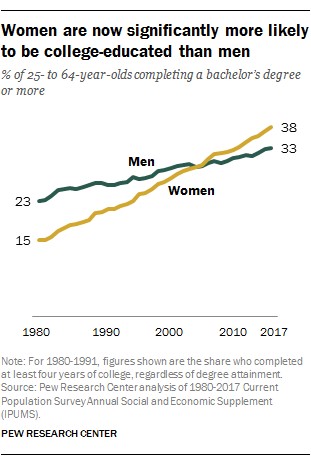Women beat men in all degree categories of higher education, and they have for decades—and worldwide. Men, it seems are slowing enrollment at an alarming rate, and young women are driving the change.
While men once outnumbered women in terms of collection enrollment by as much as 58 percent to 42 percent in the 1970s, the ratio has now almost reversed.
According to the National Center for Education Statistics, women comprised more than 56 percent of students on campuses nationwide last year. That same year, about 2.2 million fewer men than women were enrolled in college.
And it’s a trend that shows no sign of veering off course. The National Center for Education Statistics also estimates that 57 percent of college students will be women by 2026.
So who is the new minority in higher educations? Hello, Men—welcome to a brand new world.
According to U.S. Census Bureau data for 2017, women between ages 18 and 24 earned more than two-thirds of all master's degrees. Put in other terms, there were 167 women with master's degrees for every 100 men. In fact, women have held the Master’s Degree advantage in the U.S. since 1981.
Regarding professional degrees, women in the same age were handed three-quarters of professional degrees and 80 percent of doctoral degrees.

(Click to enlarge)
Source: Bloomberg
Another research study confirms the trend. In 2017, about 34.6 percent of women graduated college or obtained a higher educational degree. Compared to 1940, more than 8 times more women have attended college and nearly 6 times more men have in 2017. Related: Consumers Show ‘Extraordinary’ Shift In Sentiment
Women are gaining in educational attainment, and now we’re seeing the effects in the work force, too. A Pew Research Center report shows that among adults ages 25 to 64, women are now more likely than men to have a four-year college degree. In 2017, 38 percent of these women and 33 percent of men had a bachelor’s degree.
Women are also outpacing men in postgraduate education. In 2017, 14 percent of women ages 25 to 64 had an advanced degree, compared with 12 percent of men. That compares with 1992, when 9 percent of men and 6 percent of women in this age group had advanced degrees.

(Click to enlarge)
Source: Pew Research Center
So, why the shift? Women have taken on higher expectations, particularly in relation to their planned contributions to the country’s workforce. That means careers—and not just ‘jobs’.
Related: Uber Falling Victim to Investors’ Short-Term Thinking
That’s also changed when women want to get married.
According to the National Bureau of Economic Research, from the 1950s to the early 1970s, women tended to marry just over a year after graduation from college. Later in the 70s, that age increased by about 2.5 years. By 1981, 25 was the median age of marriage for college-educated women. That means more serious students, and the increasing availability of the contraceptive pills helped, too, as did a long fight against job discrimination.
It’s not 1950 anymore, but “the jury is still out concerning whether the full lifetime economic returns to college are greater for women than for men," according to the report’s authors.
By Damir Kaletovic for Safehaven.com
More Top Reads From Safehaven.com

















